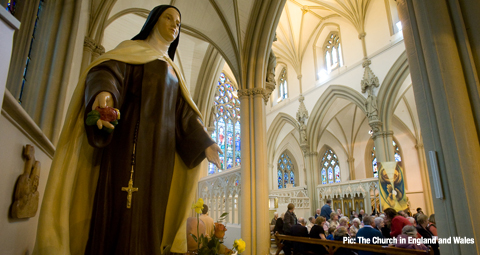BY Amanda Connelly | August 30 | ![]() 0 COMMENTS
0 COMMENTS ![]() print
print

The marvels of St Thérèse: the Scots cured by the Little Flower
Digging through historical archives, Amanda Connelly explores the stories of two women whose remarkable recovery from illness has been attributed to the Little Flower: Scottish nun Sr Catherine, who overcame a horrific foot injury, and a Glasgow woman whose tumour was cured.
St Thérèse of Lisieux, the Little Flower, the French Carmelite nun who has been venerated by Catholics across the world for decades, is arguably one of the most popular and enduring saints within the Church of today. The faithful in Scotland have been gearing up to welcome the saint to our shores, ahead of her relics arrival this week. Excitement has been building as Scotland’s eight dioceses—and indeed its clergy and lay people—prepared for the saint’s Scottish tour with prayers, services and Masses.
Yet while the momentous visit of the relics will make for a more recent connection in the minds and hearts of Scotland’s Catholic community, what cannot be ignored is the Little Flower’s fascinating links to our nation: through cures, a canon, and the Catholic community.
Most Catholics will be at least somewhat familiar with the canonisation requirements: at least two miracles must be attributed to the individual’s intercession after their death. Among the many miracles avowed to the French saint is a Scottish contingent, giving a local perspective to the enormity of the saint’s popularity.
Canon Thomas taylor
St Thérèse of Lisieux’s popularity has continued to endure in Scotland, with particular note given by the late Canon Thomas Taylor, the parish priest of St Francis Xavier’s Church in Carfin and the founder of Carfin Lourdes Grotto. His own devotion to the little Carmelite nun in France, at the time one of the universal Church’s newest saints, saw him called as one of the principal witnesses to her devotion in the English-speaking world when her canonisation cause was opened, and his devotion was an inspiration to the ever-popular Grotto, which is visited by thousands of pilgrims annually each year.
As the parish community, at the time impacted by strikes and mass unemployment, built the Grotto, Canon Taylor through its erection promoted not only devotion to Our Lady of Lourdes, but also to St Thérèse, of whose sisters he was a close friend at the Lisieux convent.
Yet, while many are aware of the then-Fr Taylor’s efforts to greater establish devotion to the saint in Scotland, the stories of the two Scottish women who helped advance devotion to the saint in the UK are perhaps somewhat lesser known.
Sr Catherine Clark
The first of the women was Sr Catherine Clark, a Scottish nun who was a postulant in the novitiate of the Congregation of the Good Shepherd in Finchley, London. In June 1908, some 11 years after the death of St Thérèse, Sr Catherine fell down two steps on a staircase, badly spraining her ankle. No amount of medication or rest would heal the pale swollen foot, which left her unable to walk.
In an effort to solve the injury, she placed a medallion of the Sacred Heart on her foot, put Lourdes water in the dressings, and said countless novenas and prayers for the intercession of a number of saints—but they were all in vain. With Sr Catherine’s parents wishing her to be treated at home in Scotland, her brother, Fr Clark at St Patrick’s Church in Shieldmuir, came to take her home on November 3.
The Sister, devastated at the thought of leaving the convent, went to bed at 9pm on the eve of her return to Scotland, and continued with a novena to the Little Flower that she had begun on Friday October 30, at the advice of her Mother Superior, and had placed a rose petal anointed by St Thérèse herself on her foot and had caressed her Crucifix as she lay in bed.
Prayers
Each time she woke, she would pray to the saint for her intercession, that she might be healed. In the Lisieux Carmel’s online archives, where a number of cures attributed to St Thérèse are documented, Sr Catherine recounts her miraculous experience: “Every time I awoke, I made her the same entreaties. At about three o’clock, I awoke again, but this time, my cell was filled with light. I did not know what to make of this splendid brightness and I cried out, ‘O God, what is this?’
“I remained surrounded by this light for about three quarters of an hour, and I couldn’t fall back to sleep, despite my efforts. Then I had the impression of someone removing the covers from my bed and urging me to stand up.
“I moved my foot and, to my great astonishment, I found the 23 feet of bandages, which had been tied very tightly and which I could not have been without, completely removed. I looked at my foot. It was perfectly cured. I stood up, walked, and, feeling no pain, I fell to my knees, crying out, ‘O Little Flower of Jesus, what is this you have done for me this morning? I am healed!’”
Recovery
When it came time for Mass to be celebrated, the Sister was able to go downstairs without the use of her cane or support of another person, with the news quickly travelling through the community. She wore ordinary shoes one again, kneeled throughout Mass, and walked up to receive Holy Communion unaided. Later examination of the Sister’s foot showed that it had returned to its natural shape and colour before the accident.
Another such case, following on one year later from Sr Catherine, was that of Helen Dorans in 1909, some 14 years before St Thérèse’s canonisation. The story of Mrs Doran’s miraculous cure through Thérèse’s intercession is documented online in the Archives du Carmel de Lisieux. Mrs Doran was a widowed mother of a large family, who had tended to her husband in his time of ill health, and had suffered in near constant pain for more than a decade with a cancerous tumour.
Following the news that the tumour was inoperable, with the cancer having spread to the rest of her organs, she went home, growing continually weaker. Unable to eat solid foods without vomiting, and with the large tumour pressing against and paralysing her internal organs, the doctor informed her that she was close to death.
Novena to the saint
Despite many priests, nuns and friends taking part in novenas for Mrs Dorans’ aid, there were no signs of recovery. As she lay dying, an old friend came to visit the woman, suggesting that a novena to Sr Thérèse be prayed. Mrs Dorans accepted the idea, as long as Faith in the Sacred Heart, the Blessed Virgin and St Joseph was not forgotten. The novena invoked them, through the intercession of the saint, beginning on August 22, 1909.
Mrs Dorans’ condition worsened over the next four days, at which point her confessor wanted her to receive the Sacrament of the Sick. Thinking she would last through the evening, she refused, wishing to receive the Sacrament at the last moments of her life. It was on the Friday, five days after the commencement of the novena, that Mrs Dorans’ condition changed in an inexplicably remarkable way.
As the archives recall: “On Friday, she was awoken by a light touch on the shoulders, as though someone were leaning over her. At the same time, she felt a soft warmth on her, much like a breath, and realised there was an invisible presence around her. Opening her eyes, she distinctly saw everything about her, down to the design on the wallpaper. All pain and suffering had vanished; she felt perfectly well, and was able to move her limbs freely.
“Dear little Sister Thérèse had come to spend a few moments of her Heaven with her, bringing her health and restoring happiness to the distraught family. With her heart overflowing with gratitude for the blessing she had just received, the scale of which she could not yet comprehend, Mrs Dorans looked at the picture of the Sacred Heart opposite her bed, said a fervent prayer of thanksgiving, and then fell asleep again for about 20 minutes.
“When she awoke, she placed her hand over the tumour and, with great astonishment and great joy, noticed that the terrible swelling which had caused her such terrible suffering had completely disappeared.
“She called her daughter, who awoke with a start, fearing upon seeing the daylight that she had been unintentionally careless. But her mother reassured her, telling her that a restorative sleep had done her good. She then asked her for a drink and was able to swallow a glassful of sparkling water before resting for half an hour.”
Miracle
When she re-awoke, she felt so well and so hungry that she asked her daughter to ‘make her a nice cup of tea and give her a fresh bread roll.’ The girl assumed this was some dying whim and, so as not to upset her mother, agreed, but not without fearing the consequences. This was the first cup of tea that Mrs Dorans had been able to enjoy in three months.
She ate half of the bread roll, to the astonishment of her children, whom she had not yet informed of the great change to her condition, and then laid back down again with a feeling of well-being. Instead of the unpleasant consequences feared, her condition further improved and her digestive system functioned normally. Then without delay, Mrs Dorans sent for the doctor, hoping that he would examine her and confirm the miraculous recovery that she knew had taken place.
On the doctor’s arrival, he noted the incredible change that had come over Mrs Dorans, both in her demeanour and the massively reduced size of the tumour and its associated swelling, adding that she had ‘defied medical possibilities and that a higher power had brought about this recovery, since it could not have been wrought by human means.’
Catalyst to saint’s visit
Although the miraculous events surrounding Sr Catherine’s and Mrs Dorans’ cures were not either of the two miracles put forward as evidence for St Thérèse’s beatification, Fr James Grant, who is in charge of the organisation of the relics’ visit to Scotland, noted that they were ‘nevertheless cures that was treated very seriously in Lisieux and were the catalyst to the Little Flower becoming better known in Scotland.’
As we today prepare to welcome the saint’s relics, Fr Grant spoke of the need to ‘take [St Thérèse] at her word as so many thousands have before us,’ just as Mrs Dorans, Sr Catherine, and all those who have been helped by the saint did, in continuing to ask for her intercession.
More prayers
“I would encourage people to pray to St Thérèse for she gave us a promise before her death that she would spend her Heaven doing good upon earth,” he said. “We must take her at her word as have so many thousands before us. So many miracles large and small have been attributed to her intercession from the earliest years after her death.
“Canon Taylor, who did so much to make this little saint known and admired, referred to these miracles as ‘roses.’ It is my fervent hope that the Little Flower of Carmel will shower many roses and blessings upon the Scottish people as they take her to their heart during her tour of our country.
“As well as the opportunity to venerate the relics of St Thérèse, I would hope that we will make the best use of this tour of the relics to get to know this little French Carmelite nun and become better acquainted with Thérèse’s spirituality: in short her Little Way where she shows us that holiness is for everyone in the Church and can be attained by all in the simplest of ways.”










